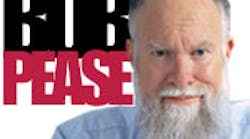I declared myself the Czar of Proofreading about 20 years ago when I found that many people were making absurd typographical errors and not correcting them or even seeing them. The new use of computers and e-mail was making it easier for everybody to type text, but harder to make it correct. Now, there ain’t no secretaries, and there ain’t no typing pool, and there ain’t no word-processing specialists. Everybody’s gotta botch up their own typing—and we sure do!
Many people agree that it’s hard to do serious, accurate proofreading from a computer screen. Printing the texts on paper helps a lot. Likewise, checking a new schematic versus an old one is pretty hard, and it’s nearly impossible if you don’t take a pencil and scribble over every item on the old schematic right after you have compared it to the new one. It’s easy to think it’s right and hard to actually get everything right.
I do know how to spell Czochralski. I have found it spelled right and wrong. Spell-checkers don’t even know how to spell it wrong. They certainly don’t know how to spell it right. Spell-checkers are mostly a snare and delusion. There are many words that the more you look at them, the more they look right, even if they’re wrong, and vice versa. That’s when even I need a dictionary. And I don’t always trust the dictionary.
Proofreading Gone Awry
This proofreading mania largely started back 38 years ago when I was at Philbrick. Some well-intentioned guy brought in a speed-reading course by Evelyn Wood. A lot of us managers and technical guys were invited to take the course. I survived the course but found that speed-reading a book did not make me happy or educated or enlightened.
Then we took a contract on a fast analog-digital system. We had made these systems before, but there was a new, improved spec. The customer had made an innocuous little change, requiring the bandwidth for measuring noise to change from 1.0 MHz to 10 MHz. The guys who were speed-reading the contracts didn’t notice the change of the decimal point.
After we noticed the change, it was too late to ask for any relief. I can assure you, it was a brutal task to get the noise down to the same level, but for a tenfold increase in bandwidth. We wasted a lot of time covering for that dumb proofreading error. We wasted a lot more time (and money) than we ever saved by speed-reading.
Since that time, I have been reading more slowly, but enjoying it more. I don’t speed-read contracts. I’m catching the errors, both typographical and philosophical. I’m catching my errors and the errors of others. My wife says I’m starting to sound like my mother.
We know that handwritten text can look pretty good, but then when it is typed, certain errors pop up. Then when it is typeset, you can find even more errors! For example, some phrases that used to look okay won’t look right once they’re in type.
Continue to next page
When I write a column, Electronic Design’s editors catch some of my errors, and I catch some of theirs. After I print out a column and proofread it twice—for enjoyment and feel and for philosophy—I read it again. Sometimes I even catch errors on a fourth reading. Usually, it’s a matter of my lousy, dubious word usage, not just typos.
I have proofread several books—and for good money. I proofread a couple of my own books, which is pretty hard, of course, as I’m too familiar with my own material. But I did well. And my columns rarely are published with a typo.
One time I was editing a book that had been typeset in a foreign land. I thought I was going crazy, but I found that some of the “compositors” were inserting sabotage errors into pages that had been good. That really kept me on my toes! I hollered and screamed, and I think we got all the errors out.
I’ve never taken a proper course on proofreading. But I’ve graduated from the University of Hard Knocks (UNH), and I’m pretty good at checking things. I know how to do it. I know that when it’s really important to get it right, reading a text out loud nice and slowly (in teams of two or three people) can catch errors that aren’t findable any other way.
How else do you explain the “Vinegar Bible,” where Chapter 20 of Luke was about “The Parable of the Vinegar” rather than the “Vineyard”? Or the “Wicked Bible” where Exodus 20:14 said, “Thou shalt commit adultery”?
I know where there used to be a highway sign, “Equestrinas Prohibited.” Now, is an equestrina a guy on a female horse, or a female riding a horse? I also know where to find a sign that says “Pedestrians Porhibited.”
Ideally, I should have written about “wireless” topics to go along with this issue’s “Wireless Everywhere” theme. I rarely run wireless signals, though I do sometimes chop out wires. One way to run some power or signals up to 100 kV+ is to use a vibrating column of air, with power transducers on the ends. Or, vibrate a teflon rod that can stand off those volts while transmitting mechanical energy.
Comments invited! [email protected] —or:
R.A. Pease, 682 Miramar Avenue
San Francisco, CA 94112-1232
BOB PEASE obtained a BSEE from MIT in 1961 and was a Staff Scientist at National Semiconductor Corp., Santa Clara, Calif.

